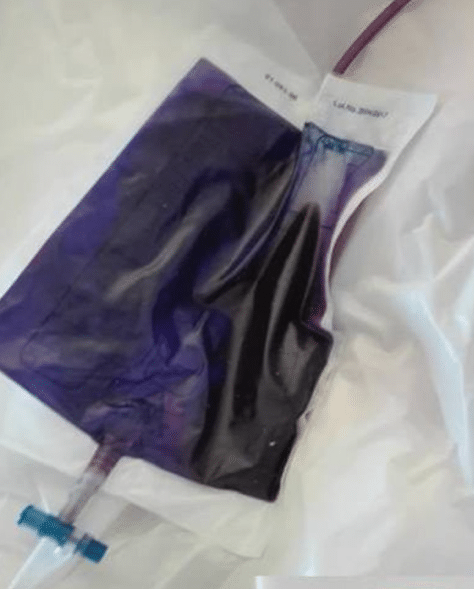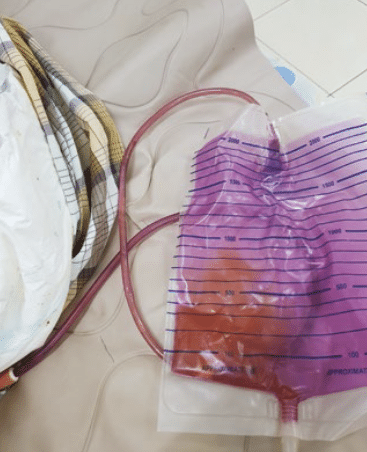Purple urine
aka Unusual Urine 009
Differential for purple urine
- Purple Urine Bag Syndrome (PUBS)
- Indicanuria due to deficiencies of tryptophan transport
- Blue Diaper Syndrome or Drummond’s syndrome
- Hartnup disease
Purple Urine Bag Syndrome (PUBS)
Purple urine bag syndrome is a rare but usually benign condition which causes the urinary catheter and bag to be stained purple. The purple hue is due to products of the breakdown of tryptophan which stain the urinary catheter materials, but the urine itself is not generally discoloured.



Mechanism
TRYPTOPHAN (bacterial flora containing tryptophases) ⟹ INDOLE (absorbed into portal circulation – undergoes hepatic conjugation and sulfation) ⟹ INDICAN (aka indoxyl sulphate; excreted in the urine, where bacteria with sulphatases and phosphatases alter)
Risk factors for purple urine bag syndrome
- Female gender
- Increased dietary tryptophan
- Increased urine alkalinity (>90% of cases)
- Severe constipation
- Chronic catheterisation
- Renal failure
- High urinary bacterial load – most common organisms identified Escherichia coli (21%), Proteus mirabilis (16.2%), Klebsiella pneumoniae (13.6%), Enterococcus (9%), and Pseudomonas aeruginosa (9%). Less common organisms reported include Providencia rettgeri, Morganella morganii, Group B Streptococci and Proteus vulgaris
Management
Management can usually just involve changing the urinary catheter and bag, with treatment with antibiotics reserved for patients with symptoms or concern for urinary tract infection.
Historical controversies
King George III is sometimes described as suffering from a historical version of ‘purple urine bag syndrome’ owing to the description of his urine by one of his personal physicians Sir Henry Halford as “the water is of a deeper colour – and leaves a pale blue ring upon the glass near the upper surface”.
This description comes from during one of King George III’s paroxysms of abdominal pain and constipation, which may have lead to increased bacterial metabolism and indole production. Historical commentators have pointed to this urine discolouration – combined with delirium, recurrent episodes of colicky abdominal pain, constipation and peripheral neuropathy – as evidence of a diagnosis of acute intermittent porphyria, with Mcalpine and Hunder therefore attributing the blue urine instead to porphyrins and porphobilin-like chromogens.
In more recent times, King George III’s diagnosis of acute intermittent porphyria has been challenged, with Peters and Wilkinson noting that blue urine is not diagnostic of porphyria and porphyric urine is actually dark reddish-brown with the porphyrins excreted as colourless precursors and darkening with time and exposure to light. There were also numerous accounts of pale urine passed by King George III during his acute attacks, even from overnight samples which would have had sufficient exposure to light to darken.
Without challenging this historical diagnosis, it at least seems likely that King George III’s chronic constipation (which can be a hallmark of acute intermittent porphyria) may have predisposed him to urinary indican production and the discoloration observed by his physicians either attributable to urinary tract infection or bacteria present in the chamber-pot leading to one of the first historical descriptions of purple urine bag syndrome.
References
- Drummond KN, Michael AF, Ulstrom RA, Good RA. The blue diaper syndrome: familial hypercalcemia with nephrocalcinosis and indicanuria; a new familial disease, with definition of the metabolic abnormality. Am J Med. 1964 Dec;37:928-48.
- Macalpine I, Hunter R. The “insanity” of King George 3d: a classic case of porphyria. Br Med J. 1966 Jan 8;1(5479):65-71
- Arnold WN. King George III’s urine and indigo blue. Lancet. 1996 Jun 29;347(9018):1811-3.
- Peters P, Merlo J, Beech N, Giles C, Boon B, Parker B, Dancer C, Munckhof W, Teng HS. The purple urine bag syndrome: a visually striking side effect of a highly alkaline urinary tract infection. Can Urol Assoc J. 2011 Aug;5(4):233-4
- Kalsi DS, Ward J, Lee R, Handa A. Purple Urine Bag Syndrome: A Rare Spot Diagnosis. Dis Markers. 2017;2017:9131872
- Rooney H, Mokool L, Ramsay A, Nalagatla S. Purple urine bag syndrome: a truly harmless sign? Scott Med J. 2018 Aug;63(3):99-101.
- Pandey S, Pandey T, Sharma A, Sankhwar S. Purple urinary bag syndrome: what every primary healthcare provider should know. BMJ Case Rep. 2018 Jul 18;2018:bcr2018226395
- Sabanis N, Paschou E, Papanikolaou P, Zagkotsis G. Purple Urine Bag Syndrome: More Than Eyes Can See. Curr Urol. 2019 Nov;13(3):125-132
- Boo WH. An elderly man with purple urine. AJGP 2021; 50(6):
[cite]
Unusual Urine
Clinical cases
Physician in training. German translator and lover of medical history.


